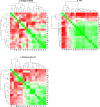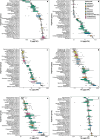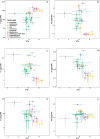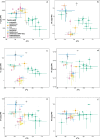Trophic Transfer of Cd, Cu, Pb, Zn, P and Se in Dutch Storage Water Reservoirs
- PMID: 38245635
- PMCID: PMC11032288
- DOI: 10.1007/s00244-023-01041-x
Trophic Transfer of Cd, Cu, Pb, Zn, P and Se in Dutch Storage Water Reservoirs
Abstract
Heavy metals are naturally omnipresent in aquatic systems. Excess amounts of heavy metals can accumulate in organisms of pollution impacted systems and transfer across a food web. Analysing the food web structure and metal contents of the organisms can help unravel the pathways of biomagnification or biodilution and gain insight in trophic linkages. We measured heavy metals and other elements in mussel bank detritus and organisms of the Biesbosch reservoirs (the Netherlands) and linked those to stable isotopic signatures. The heavy metal contents (cadmium, copper, lead, and zinc) were often lowest in benthivorous, omnivorous and piscivorous species (mainly fish); whereas, phosphorus contents were lower in the autotrophs. Mussel bank detritus contained the highest amounts of heavy metals. The heavy metals were negatively correlated with δ15N values. For selenium no clear trend was observed. Furthermore, there was a negative correlation between fish length and some heavy metals. Based on all 20 analysed elemental contents, similarities between species became apparent, related to niche or habitat. This study confirms that elemental contents of species can differ between feeding guilds and/or species, which can be attributed to metabolic and physiological processes. The organisms in higher trophic levels have adaptations preventing metal accumulation, resulting in lower contents. Within the fish species biodilution occurs, as most metal contents were lowest in bigger fish. Overall, the metals did not seem to biomagnify, but biodilute in the food web. Metal analyses combined with isotopic signatures could thus provide insights in metal transfer and possible trophic linkages within a system.
© 2024. The Author(s).
Conflict of interest statement
The authors have not disclosed any conflict of interest.
Figures







Similar articles
-
Temporal distribution patterns of metals in water, sediment, and components of the trophic structure in a tropical coastal lagoon of the Gulf of Mexico.Environ Sci Pollut Res Int. 2022 Sep;29(41):61643-61661. doi: 10.1007/s11356-021-17815-6. Epub 2022 Jan 12. Environ Sci Pollut Res Int. 2022. PMID: 35020148
-
Trophic transfer of heavy metals through aquatic food web in a seagrass ecosystem of Swan Lagoon, China.Sci Total Environ. 2021 Mar 25;762:143139. doi: 10.1016/j.scitotenv.2020.143139. Epub 2020 Oct 16. Sci Total Environ. 2021. PMID: 33138994
-
Heavy metals in marine food web from Laizhou Bay, China: Levels, trophic magnification, and health risk assessment.Sci Total Environ. 2022 Oct 1;841:156818. doi: 10.1016/j.scitotenv.2022.156818. Epub 2022 Jun 18. Sci Total Environ. 2022. PMID: 35728646
-
Do Cd, Cu, Ni, Pb, and Zn biomagnify in aquatic ecosystems?Rev Environ Contam Toxicol. 2013;226:101-22. doi: 10.1007/978-1-4614-6898-1_4. Rev Environ Contam Toxicol. 2013. PMID: 23625131 Review.
-
Heavy metal concentrations in various tissues of two fish species from Damsa Dam Lake (Turkey) and associated health risk assessment.J Trace Elem Med Biol. 2024 Jan;81:127339. doi: 10.1016/j.jtemb.2023.127339. Epub 2023 Nov 7. J Trace Elem Med Biol. 2024. PMID: 37976961 Review.
References
-
- Aarts BG, Nienhuis PH. Fish zonations and guilds as the basis for assessment of ecological integrity of large rivers. Hydrobiologia. 2003;500:157–178. doi: 10.1023/A:1024638726162. - DOI
-
- Ahmed ASS, Sultana S, Habib A, Ullah H, Musa N, Hossain MB, et al. Bioaccumulation of heavy metals in some commercially important fishes from a tropical river estuary suggests higher potential health risk in children than adults. PLoS ONE. 2019;14(10):e0219336. doi: 10.1371/journal.pone.0219336. - DOI - PMC - PubMed
-
- Al-Aasm I, Clarke J, Fryer B. Stable isotopes and heavy metal distribution in Dreissena polymorpha (Zebra Mussels) from western basin of Lake Erie, Canada. Environ Geol. 1998;33:122–129. doi: 10.1007/s002540050232. - DOI
-
- Alcorlo P, Baltanás A. The trophic ecology of the red swamp crayfish (Procambarus clarkii) in Mediterranean aquatic ecosystems: a stable isotope study. Limnetica. 2013;32(1):121–138. doi: 10.23818/limn.32.12. - DOI
MeSH terms
Substances
LinkOut - more resources
Full Text Sources

